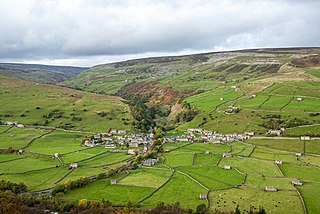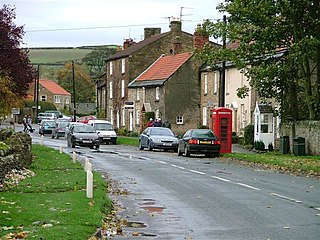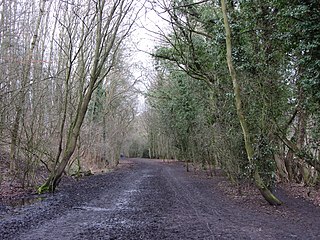
The River Swale in Yorkshire, England, is a major tributary of the River Ure, which becomes the River Ouse, that empties into the North Sea via the Humber Estuary. The river gives its name to Swaledale, the valley through which it flows.

Gunnerside is a village in North Yorkshire, England. It is situated in Swaledale, on the B6270 road, 3 miles (5 km) east of Muker and 6 miles (10 km) west of Grinton. The village lies between the River Swale and its tributary, Gunnerside Beck, and is within the Yorkshire Dales National Park.

Dalton is a village and civil parish in North Yorkshire in England. Dalton is situated about six miles north-west of Richmond and about five miles south-east of Barnard Castle within the council district of Richmondshire and close to the A66 trans-Pennine trunk road. It was listed in the Domesday book. The Dalton parish boundary includes the village itself as well the houses at Dalton Heights plus numerous surrounding farms. The population of the parish was 147 according to the 2001 census, increasing to 181 at the 2011 Census.

Bolton-on-Swale is a village and civil parish in the Richmondshire district of North Yorkshire, England. In 2015, North Yorkshire County Council estimated the population of the civil parish to be 70.

Brompton-on-Swale is a village and civil parish in the Richmondshire district of North Yorkshire, England. The village is located three miles east of Richmond and 10 miles (16 km) north-west of the county town of Northallerton on the northern bank of the River Swale.

Skeeby is a village and civil parish about 18 miles (29 km) north-west of the county town of Northallerton in North Yorkshire, England.

Gilling West is a village about 3.5 miles (5.6 km) north of Richmond in the Richmondshire district of North Yorkshire, England. It is located in the civil parish of Gilling with Hartforth and Sedbury. It is named "West" to distinguish it from Gilling East in Ryedale, some 32 miles away.

Downholme is a village and civil parish in North Yorkshire, England. It is situated approximately 4 miles (6 km) west from the market town of Richmond and 16 miles (26 km) west from the county town of Northallerton. The village lies close to the edge of the Yorkshire Dales. The population as taken in the ONS Census of 2011 was less than 100, so details are included in the parish of Hudswell. In 2015, North Yorkshire County Council estimated the population of the village to be 50.

Easby is a hamlet and civil parish in the Richmondshire district of North Yorkshire, England. It is situated near Richmond on the banks of the River Swale, approximately 12 miles (19 km) north west from the county town of Northallerton. The population taken by ONS was less than 100. Population information is included in the parish of Hudswell.

Appersett is a hamlet in the Yorkshire Dales in the Richmondshire district of North Yorkshire, England one mile (1.6 km) west of Hawes. It lies on the A684 road and an unclassified road runs alongside Widdale Beck to connect with the B6255 road between Hawes and Ingleton.

Uckerby is a hamlet and civil parish in the Richmondshire district of North Yorkshire, England. It situated at a crossroads on the road between Scorton and Moulton. The hamlet lies 9.2 miles (14.8 km) north west of the county town of Northallerton.

Richmond railway station was a railway station that served the town of Richmond in North Yorkshire, England. The station was the terminus of a branch line that connected with what would become the East Coast Main Line.

The A684 is an A road that runs through Cumbria and North Yorkshire, starting at Kendal, Cumbria and ending at Ellerbeck and the A19 road in North Yorkshire. It crosses the full width of the Yorkshire Dales, passing through Garsdale and the full length of Wensleydale.

The A6108 road is an A road in North Yorkshire, England. It runs from the south of Scotch Corner to Ripon going via Richmond and Leyburn across the moors and the valleys of Swaledale and Wensleydale. The road is 37 miles (60 km) long, but through traffic between the two destinations will find a shorter route of 26 miles (42 km) by going south on the A1. The route is single carriageway for its entire length.

The A6136 is a 4 digit A road in North Yorkshire, England. It runs between the A6108 Queen's Road, in the market town of Richmond, before terminating on the A6055 in Catterick, near the A1(M) Junction 52.

The Richmond to Lancaster Turnpike, was a road that was opened in the second half of the 18th century between Richmond, in the North Riding of Yorkshire and Lancaster in Lancashire, Northern England. The turnpike was built to allow goods to be taken from Yorkshire to the port of Lancaster. It was approved in 1751, but was not wholly completed until 1774.

St Martin's is a civil parish in North Yorkshire, England. It is located south of the town of Richmond, covering the residential areas south of the River Swale, including the former Richmond railway station and Holly Hill.
Brompton-on-Swale is a civil parish in the former Richmondshire district of North Yorkshire, England. It contains 29 listed buildings that are recorded in the National Heritage List for England. All the listed buildings are designated at Grade II, the lowest of the three grades, which is applied to "buildings of national importance and special interest". The parish contains the village of Brompton-on-Swale and the surrounding countryside. Most of the listed buildings are houses, cottages and associated structures, farmhouses and farm buildings, the majority of them along Richmond Road in the village. The other listed buildings include a bridge, a church, a milepost and a war memorial.

Mercury Bridge, is a grade II listed structure that crosses the River Swale in North Yorkshire, connecting the town of Richmond to the south side of the river. The bridge was commissioned by the railway company whose Richmond railway station terminus lay across the river, and so provided ease of access to Richmond town where there had not been a bridge before. The bridge now carries the A6136 road and was renamed from Station Bridge in 1975 in honour of the Royal Corps of Signals. The bridge was noted for being one of a few railway-owned bridges which carried no rails.

Green Bridge is a road bridge crossing the River Swale in Richmond, North Yorkshire, England. Until the building of Mercury Bridge adjacent to the railway station in 1846, it was the only crossing over the River Swale from Richmond. Historically, the bridge carried the Richmond to Lancaster Turnpike, and is now a grade II* listed structure.





















